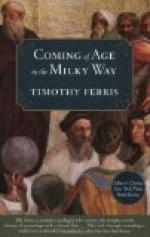
|
| Name: _________________________ | Period: ___________________ |
This test consists of 5 multiple choice questions, 5 short answer questions, and 10 short essay questions.
Multiple Choice Questions
1. When was Charles Darwin born?
(a) 1853.
(b) 1798.
(c) 1902.
(d) 1809.
2. Who concluded that the process of the earth's creation was part of an infinite repeating cycle of development and destruction?
(a) Aristotle.
(b) Edwin Hubble.
(c) Fred Hoyle.
(d) George Gamow.
3. When was "Evolution of the Universe" written?
(a) 1999.
(b) 1979.
(c) 1972.
(d) 1985.
4. What German mathematician provided evidence that every conservation law is based on symmetry?
(a) William Parsons.
(b) Jean Richer.
(c) Albert Einstein.
(d) Emmy Noether.
5. Lambert wrote in his "Cosmological Letters" that the sun was a star on the a disc-shaped system of stars known as what?
(a) The Milky Way.
(b) The sun.
(c) Dark matter.
(d) Lepton.
Short Answer Questions
1. What Russian scientist theorized that the beginning of the universe may have started with a core so hot and dense that it created nuclear fusion and created the elements now known to man?
2. Who estimated that the existence of over one hundred thousand such spiral nebulae was possible?
3. Where did Charles Darwin find marine fossils on mountaintops?
4. When was Albert Einstein born?
5. What is a branch of physics that studies the existence and interactions of particles that are the constituents of what is usually referred to as matter or radiation?
Short Essay Questions
1. What influences led William Herschel in his studies of nebulae, according to the author in Chapter 8: "Deep Space"?
2. How are nebulae defined in Chapter 8: "Deep Space"? What are the different classes of nebulae?
3. What does the author state mankind has come to with the universe in Chapter 20: "The Persistence of Mystery"? Why?
4. What discoveries does the author describe regarding spiral nebulae in Chapter 9: "Island Universes"?
5. How does the author describe theoretical physicists in Chapter 16: "Rumors of Perfection"?
6. What led to the emergence of quantum physics according to the author in Chapter 15: "The Quantum and its Discontents"?
7. What led to the origination of spectroscopy and astrophysics, according to the author in Chapter 10: "Einstein's Sky"?
8. What does the author assert man has always speculated about in Chapter 18: "The Origin of the Universe"?
9. Who associated the red-shift of the galaxies with Einstein's relativity, according to the author in Chapter 12: "Sermons in Stones"?
10. What evidences does the author suggest implies extraterrestrial life in Chapter 19: "Mind and Matter"?
|
This section contains 869 words (approx. 3 pages at 300 words per page) |

|




